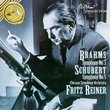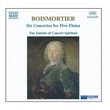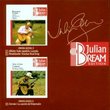| All Artists: Jascha Heifetz Title: Collection 32 Members Wishing: 0 Total Copies: 0 Label: RCA Release Date: 6/17/1997 Genre: Classical Styles: Chamber Music, Historical Periods, Classical (c.1770-1830), Modern, 20th, & 21st Century, Instruments, Strings Number of Discs: 1 SwapaCD Credits: 1 UPC: 090266176328 |
Search - Jascha Heifetz :: Collection 32
 | Jascha Heifetz Collection 32 Genre: Classical
|
Larger Image |
CD DetailsSimilar CDs
|
CD ReviewsClassic performances Chicagotinnitus | chicago | 07/14/2002 (5 out of 5 stars) "One tires of writing too many Heifetz reviews because the adjectives always remain the same - brilliant, intense, brisk, passionate, and flawlessly in tune. The Strauss remains a classic, undiminished through the years. A more assertive pianist may have colored the phrases with more character, but violinistically Heifetz paints a masterpiece. Intonation is pristine, phrasing is delicate. He captures well the blithe nimbleness in the work's opening and the grandeur of its finale. His rendering of the second movement leaves one in tears. The chamber works are full of flair, especially in the Dohnanyi, where Primrose's burnished tone is cause for celebration. In the Brahms, perhaps more so than in the other works, one must be forgiving to the engineering of the time. Nevertheless, its a joy to hear such inspired collaboration between stars." Heifetz' second recording of Strauss' Sonata - sometimes har Discophage | France | 03/19/2008 (4 out of 5 stars) "If my records are right, Heifetz made three recordings of Strauss' youthful Violin and Piano Sonata: in 1934 with pianist Arpad Sandor (I have it on Biddulph, Plays Strauss & Prokofiev, but it is also on the Heifetz collection vol 2: Heifetz Collection, Vol. 2 (1925-1934) (3 CDs)), this one from 1954, and finally on the occasion of his farewell concert, on Oct. 23, 1972 (Heifetz Collection, Vol. 46: The Final Recital) - the two latter with Brooks Smith, one of Heifetz usual and most faithful partners. The second is in many ways considered the classic version, and it is certainly typical of the kind of approach Heifetz applied to just about everything he tackled from the 1940s on - to encapsulate it in one word: fast. Let me elaborate: applying an unrelenting forward drive, with little time for any lyrical lingering. Those who maintain that it is not a question of speed but just of clarity of articulation should use a stopwatch! Sometimes it is convincing, as it brings an awesome tension and devastating lyrical intensity to the music (as in, say, Brahms' second Sextet, Heifetz Collection Vol.41). Sometimes it just sounds ludicrously rushed, as in Schubert's C-major Quintet, which reminds me of those old films shot at 24 images/sec and aired on TV at 25 (Schubert: Quintet, D. 956; Trio, D. 581; Ave Maria; Bach: 3 Sinfonias).
The 1954 Strauss is very typical (and the 1972 concert is remarkably similar, in some movements to the second), and as such very different from Heifetz' more relaxed, "middle-of-the-road" first recording. Just compare the timings: 9:55 to 10:35 in the first movement, 7:32 to 8:03 in the second (the 1972 concert is even faster at 7:19), with only the finale being relatively similar, 7:21 to 7:29. Both work. I have no intention of disparaging the earlier interpretation - superbly lyrical, full in tone, with a fine grasp of the Sonata's sprawling architecture and expression, and a somewhat too sentimentally slow second movement - if I say that overall, I find the 1954 approach quite convincing. It imparts the Sonata with an unflinching drive and a fiery lyrical intensity which I find irresistible. Don't infer that Heifetz is metronomic, on the contrary, his phrasings are finely inflected and his transitions very expressive. But unlike many other versions, one feels that he isn't playing his phrases bar by bar, but that he has the control of the long lyrical line. There is not a trace of the kind of swooning languidness that others bring to the music. Where I find that Heifetz 1954 does score over the earlier version is in the forward-moving and naturally-flowing tempo he adopts in the second movement, true to the "andante cantabile" tempo indication and the improvisatory nature of the movement. In that approach the music sounds like a wistful meditation rather than a sentimental "encore" - Heifeitz' superbly controlled dynamics work to the same effect. Now, among the drawbacks, there are passages in the first movement that simply feel too rushed and hard-driven, especially when they force Brooks Smith to smudge his double notes (1:16 and thereafter). The Sonata's very opening phrase, with its typical rhythmic signature (accented 16th note and 8th note-triplet) also has a playful and jaunty quality that, well, takes some getting used to. In the finale, Heifetz, as in 1934 and again in 1972, practices an unfortunate 42 measure, circa 40" cut (6:33); while I can understand the rationale for it given the time constraints of the 78rpm shellacs, I see no justification for pursuing the bad habit into the LP era - a bad habit unfortunately passed on to others in the CD era as well, such as Chung in her famed recording with Krystian Zimmermann (Strauss: Sonata For Violin and Piano/Respighi:Sonata For Violin and Piano). In comparison to the 1934 recording, and all amends made for the 78rmp transfer, Heifetz' tone in 1954 sounds razor sharp and luminous, but not very full, and the recording is, as always with the RCA Heifetz recordings, dry. Smith is an able partner, given by the recording perspective (as could be expected) a relatively backward placement in comparison to the violin, but still allowing the required presence in his dialoguing with the fiddler. Still I wish it had been more present in some of the more tumultuous and passionately lyrical passages of the finale (2:13 and after), especially when the piano picks up the melody and the violin clearly assumes an accompaniment role. Note that I do not have this particular CD, volume 32 of the thorough and short-lived RCA Heifetz collection published in 1994, now oop and for which scandalous prices are asked by the internet vultures (hence my absence of comments on the Brahms trio and Dohnanyi's endearing Serenade). Shame on BMG/RCA for letting the series lapse so rapidly. What I have is volume 12 of the Japanese RCA/BMG Heifetz edition (The Art of Jasha Heifetz), which pairs the Strauss Sonata with Schubert's Sonatina D 408 (Emmanuel Bay 1953) and Brahms 3rd Sonata (William Kapell 1950). It is not listed on this site, but you can find it on the Japanese sister company, ASIN B00005S052, for about 16 bucks at the present, plummeting dollar rate. Even adding postage and bank conversion fees, it remains a good deal. " |

 Track Listings (12) - Disc #1
Track Listings (12) - Disc #1


